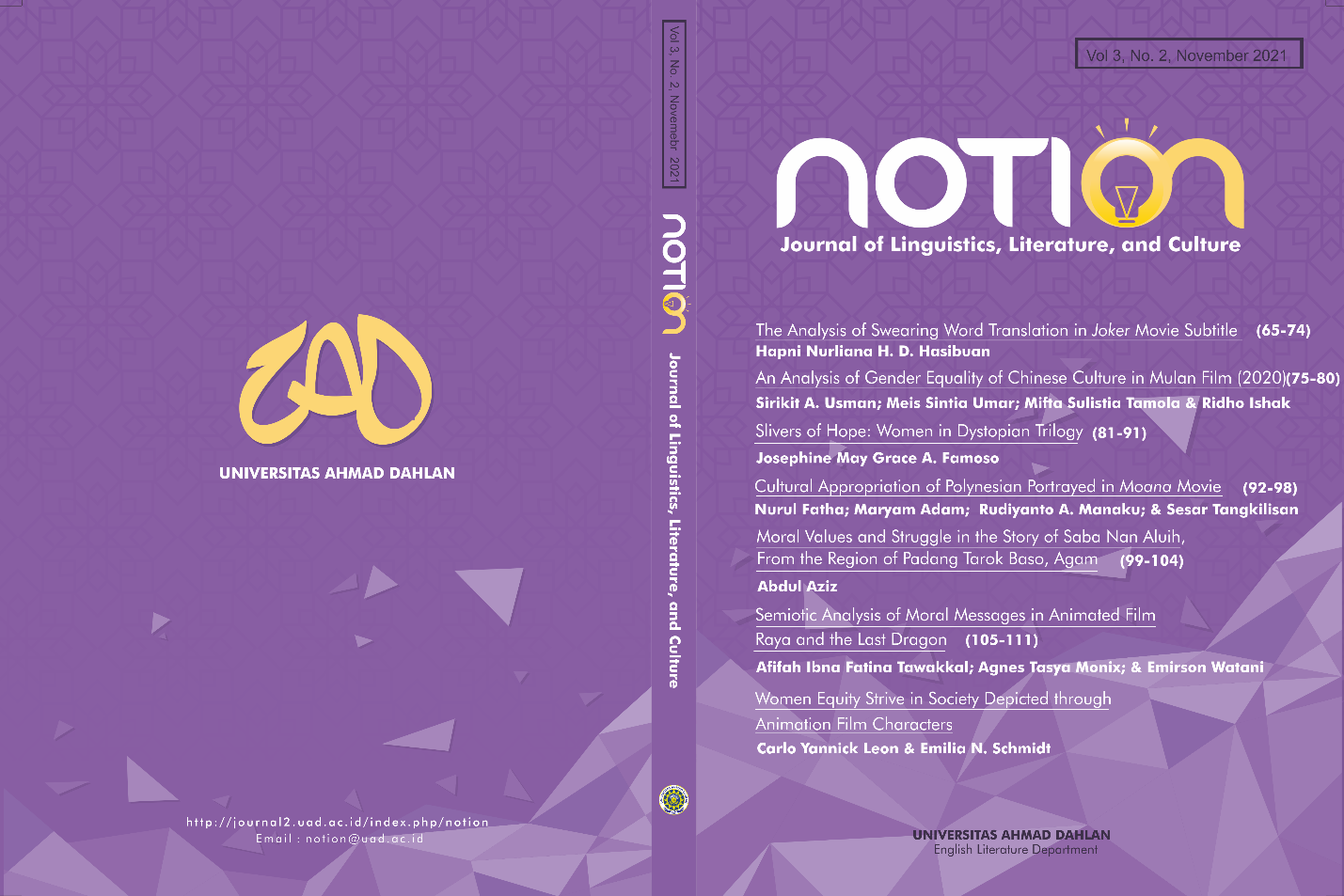Women Equity Strive in Society Depicted through Animation Film Characters
DOI:
https://doi.org/10.12928/notion.v3i2.4818Keywords:
Female Representations, Second-wave Feminism, Disney Renaissance, Gender Equity, Film CharacterAbstract
The purpose of this research is to identify the female representation depicted in the Disney Renaissance and to investigate why Disney characters struggle to claim their equity as women in their society. The research methods used in this study are classified as qualitative and descriptive. The documentation method and taking notes techniques are used to collect data. The research also employs two method concepts to analyze the collected data, including a gender equity approach analysis and Simone de Beauvoir's second-wave feminism theory. The data consists of linguistic units from various Disney Renaissance stories. The writer discovered three parts in the description of female representations based on data analysis of the female representations depicted in Disney Renaissance: rebel, wise, and adventurous women; confident, intelligent, and repellent of domestication women; and masculine, loyal, and ambitious women. Furthermore, data analysis of Disney characters' struggles in claiming their equality as women in their society reveals that they outperform patriarchal expectations, reject domestication, and practice emancipation by appropriating masculine attributes and roles.
References
Ramrao, D. T. (2016). Film and Literature: An Overview. International Journal of Multidisciplinary Research, 150.
May, J. P. (1981). Walt Disney's Interpretation of Children's Literature. Language Arts, Vol. 58, No. 4, Children's Literature, 464.
Tonn, T. (2008). Disney's Influence on Females Perception of Gender and Love. A Research Paper, 5.
Beal, C. (1994). Boys and girls: The development of gender roles. New York: McGraw-Hill.
Lant, J. (2018, SEPTEMBER 7). A Briefish History of The Disney Renaissance. Retrieved from theopinionarcade: https://theopinionarcade.com/a-briefish-history-of-the-disney-renaissance/
Abler, A. (2005). The Moral of the Story (Society and Culture, Ethics and Morality). Retrieved from VISION: https://www.vision.org/the-moral-of-the-story-fairy-tales-mirror-society-981
Stover, C. (2013). Damsels and Heroines: The Conundrum of the Post-Feminist Disney Princess. A Journal of Transdisciplinary Writing and Research h from Claremont Graduate University: Vol. 2: Iss. 1, Article 29., 4.
Lindgren, A. (2020). Animated Stereotypes – An Analysis of Disney’s Contemporary Portrayals of Race and Ethnicity. Master Thesis, 90.
Garabedian, J. (2014). Animating Gender Roles: How Disney is Redefining the Modern Princess. James Madison Undergraduate Research Journal, 2(1), 22-25.
Barber, M. (2015). Disney’s Female Gender Roles: The Change of Modern Culture. Honors Thesis.
Walsh, K. T. (2010, March 12). The 1960s: A Decade of Change for Women. Retrieved from U.S News: https://www.usnews.com/news/articles/2010/03/12/the-1960s-a-decade-of-change-for-women
CIDA. (1999). CIDA's policy on gender equality. Hull, Quebec: Canadian International Development Agency.
Moran, M. (1989). 1930s, America-Feminist Void? The Status of the Equal Rights Movement during the Great Depression. The Department of History as the Outstanding Paper for the 1988-89 academic year.
Tongs, R. (2009). Feminist Thought Third Edition. Boulder : Westview Press.
Drucker, S. A. (2018, April 27). Betty Friedan: The Three Waves of Feminism. Retrieved from Ohio Humanities (Blog and News): http://www.ohiohumanities.org/betty-friedan-the-three-waves-of-feminism/#:~:text=The%20second%20wave%2C%20at%20its,to%2C%20second%2Dwave%20feminism.&text=This%20causes%20women%20to%20lose,in%20that%20of%20their%20family.
Anand, T. (2018, April 25). A Brief Summary Of The First Wave Of Feminism. Retrieved from FII (Feminism in India): https://feminisminindia.com/2018/04/25/summary-second-wave-of-feminism/
Kristen Schiele, L. L. (2020). Marketing feminism in youth media: A study of Disney and Pixar animation. journals elsevier, 2 .
Salden, M. (2019). ‘Disney’s Damsels’ A representation of femininity in Disney’s animated movies Snow White, Mulan, and Brave. Master Thesis Creative Industries Radboud University Nijmegen, 6.
Beck, K. A. (2018). Beyond the Independent Woman: A Reading of Simone de Beauvoir’s When Things of the Spirit Come First with The Second Sex. School of Historical and Philosophical Inquiry, 18.
Walters, M. (2005). Feminism: A Very Short Introduction. United States: Oxford University Press Inc., New York.
Berg, B. L. (2007). Qualitative Research Methods for the Social Sciences (6th ed). California State University, Long Beach: Pearson.
Tur, A. P. A. & Sari, F.A. (2019). Reshaping the society face through the culture of horror told in Shirley Jackson’s the lottery. Notion: Journal of Linguistics, Literature, and Culture, Vol. 1 (1), p. 1-7. http://www.journal2.uad.ac.id/index.php/notion/article/download/709/377
Tur, A. P. A. & Putri, S. A. (2020). Codes of teenage characters and mama in their talks portraying the sociolinguistic features. Leksika: Jurnal Bahasa, Sastra dan Pengajarannya Vol 14 (2), p. 46-51. http://www.jurnalnasional.ump.ac.id/index.php/LEKSIKA/article/viewFile/7638/3318
Sawyer, N. (2003). Feminist Outlooks at Disney Princess‘s. James Madison University, 3.
FitzGerald, C. (2019, August 03). A Defence of the Princesses of Disney’s Renaissance. Retrieved from medium.com: https://medium.com/
Downloads
Published
Issue
Section
License
Copyright (c) 2021 Carlo Yannick Leon

This work is licensed under a Creative Commons Attribution 4.0 International License.
Authors who publish their articles in NOTION: journal of Linguistics, Literature, and Culture agree to the following terms:
- Authors retain the copyright and grant the journal right of first publication with the work simultaneously licensed under a Creative Commons Attribution 4.0 International License that allows others to share the work with an acknowledgement of the work's authorship and initial publication in this journal.
- Authors are able to enter into separate, additional contractual arrangements for the non-exclusive distribution of the journal's published version of the work (e.g., post it to an institutional repository or publish it in a book), with an acknowledgement of its initial publication in this journal.
- Authors are permitted and encouraged to post their work online (e.g., in institutional repositories or on their website) prior to and during the submission process, as it can lead to productive exchanges, as well as earlier and greater citation of published work.





